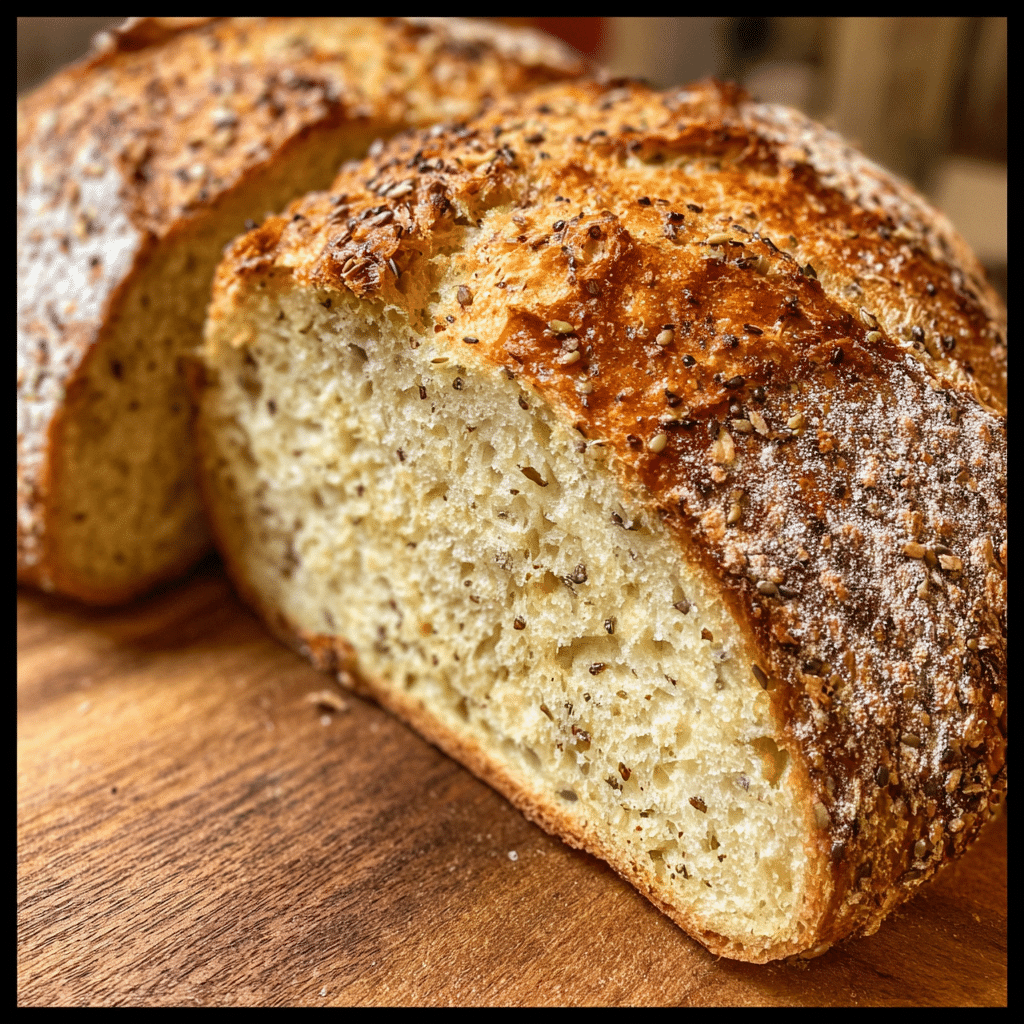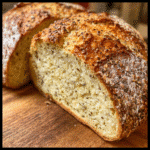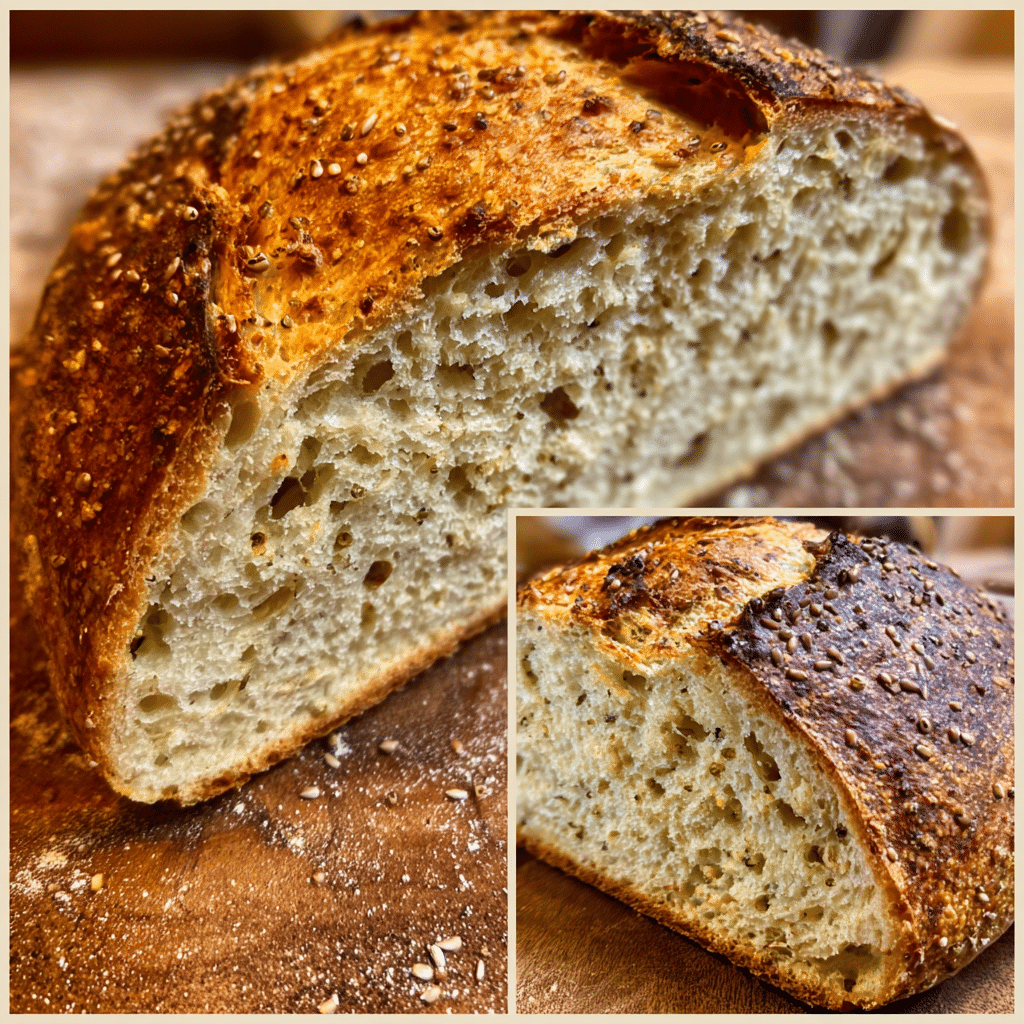If you’ve ever stood in your kitchen wondering whether it’s actually possible to enjoy bread on a sensitive stomach and a keto diet—then you’re not alone. That’s exactly where I was, a few years back, right after one too many store-bought slices left me bloated and blah.
That’s what inspired me to create this low FOD bread recipe—something gut-friendly, keto-aligned, and truly comforting. In this article, I’ll walk you through everything I’ve learned about baking bread that’s easy on your belly, free of common triggers like gluten and high-FODMAP flours, and still warm, delicious, and satisfying.
Whether you’re living with IBS, following a keto lifestyle, or just curious about low-FODMAP baking, this guide is for you.

Table of Contents
The Best Low FOD Bread Recipe for Gut Health and Keto Living
Why I Had to Rethink My Bread (and Maybe You Do Too)
If you’re anything like me, bread used to be a comfort food—and then it became a trigger. Back in my early twenties, when I first started noticing digestive issues, I never imagined my favorite toasted sourdough could be behind the bloat. But it was. And it turns out, I wasn’t alone.
That’s when I stumbled upon the concept of low FODMAP foods. These are foods that are lower in certain fermentable sugars that tend to mess with the gut—especially for those with IBS or food sensitivities.
Once I learned about low FOD bread, something clicked. I didn’t have to give up bread completely—I just had to make it smarter.
What Is Low FOD Bread Exactly?
Low FOD bread is a type of bread made without common high-FODMAP ingredients—like wheat, rye, barley, honey, and even certain dairy products. Instead, it uses ingredients that are easier to digest, like almond flour, coconut flour, and psyllium husk.
It’s also a favorite in the keto community because those very ingredients are naturally low in carbs. Double win.
And here’s the kicker: when done right, low FOD bread can actually taste amazing.
In fact, according to Monash University, one of the leading authorities on the low FODMAP diet, many people with IBS find relief just by swapping out traditional bread for FODMAP-friendly alternatives.
Who Is This Bread Really For?
If you’re wondering whether low FOD bread is worth the hype, here’s who it helps most:
- People avoiding gluten or wheat for digestive comfort
- Low-carb or keto eaters who still miss a good sandwich
- Folks with sensitive stomachs who want to ditch the bloat
- Busy home cooks who want quick, nourishing solutions
And you know what? You don’t even have to fall into one of those categories to love this bread. If you’re someone who craves simplicity, warmth, and healing in your kitchen—then this one’s for you.
Print
Quick & Healthy Low FOD Bread Recipe for Gut-Friendly Keto Baking
- Total Time: 1 hour 5 minutes
- Yield: 1 loaf (12 slices) 1x
Description
This easy low FOD bread is gut-friendly, gluten-free, and keto-approved—perfect for IBS relief without compromising taste or texture.
Ingredients
2 cups almond flour
1/4 cup flaxseed meal
1/4 cup psyllium husk powder
1 tbsp baking powder (gluten-free)
1/2 tsp sea salt
3 large eggs
1/4 cup olive oil
3/4 cup unsweetened almond milk
1 tsp apple cider vinegar
Instructions
1. Preheat your oven to 350°F (175°C). Line a loaf pan with parchment paper.
2. In a large bowl, whisk together almond flour, flaxseed meal, psyllium husk, baking powder, and salt.
3. In another bowl, beat eggs, then mix in olive oil, almond milk, and apple cider vinegar.
4. Pour wet ingredients into the dry ingredients and stir until a thick dough forms.
5. Transfer dough to the loaf pan and smooth the top with a spatula.
6. Let the dough sit for 5 minutes to allow the psyllium to activate.
7. Bake for 50–55 minutes or until the top is golden and a toothpick comes out clean.
8. Let it cool in the pan for 10 minutes, then transfer to a wire rack to cool completely.
9. Slice and serve with your favorite low FODMAP toppings.
Notes
Store in an airtight container in the fridge for up to 5 days, or freeze sliced portions for quick future use.
Best enjoyed toasted with ghee or mashed avocado.
Adjust baking time slightly depending on altitude or oven performance.
- Prep Time: 10 minutes
- Cook Time: 55 minutes
- Category: Breakfast
- Method: Baking
- Cuisine: American
Nutrition
- Serving Size: 1 slice
- Calories: 170
- Sugar: 0.5g
- Sodium: 210mg
- Fat: 15g
- Saturated Fat: 2g
- Unsaturated Fat: 11g
- Trans Fat: 0g
- Carbohydrates: 5g
- Fiber: 3g
- Protein: 6g
- Cholesterol: 55mg
Keywords: low FOD bread, keto bread, gluten-free bread, gut-friendly bread
What Is Low FOD Bread?
Understanding FODMAPs in Bread
So what exactly is the deal with FODMAPs and bread? Trust me—I used to wonder the same thing while staring down the bakery aisle with confusion and a very gurgly stomach.
FODMAPs are types of fermentable carbs—Fermentable Oligosaccharides, Disaccharides, Monosaccharides, and Polyols—that can cause major discomfort in some people. When you eat a standard slice of bread, those FODMAPs often ferment in your gut, causing bloating, cramps, and all kinds of unwelcome drama.
What Makes a Bread High or Low in FODMAPs?
Whether a bread is high or low in FODMAPs depends entirely on its ingredients and how it’s made.
High FODMAP breads usually contain:
- Wheat flour or whole wheat
- Rye or barley
- Milk or whey powder
- Sweeteners like honey or high-fructose corn syrup
These ingredients are rich in short-chain carbs that your small intestine may struggle to digest.
Low FOD bread, on the other hand, skips the gut-troubling culprits. Instead, it’s made with:
- Almond or coconut flour
- Psyllium husk
- Eggs or flax for structure
- Gut-friendly fats like olive oil
Those swaps not only make the bread easier to digest—they also help it stay firmly keto-friendly and gluten-free.
Common High FODMAP Ingredients in Store-Bought Bread
Next time you’re at the store, flip over the label and check for:
- Enriched wheat flour
- Inulin (often added for fiber but tough on IBS!)
- Chicory root
- Honey or molasses
- Milk solids or dry skim milk
Even breads labeled “whole grain” or “natural” can still sneak in ingredients that mess with digestion.
What Makes a Bread Gut-Friendly and Keto-Friendly?
To be truly gut-friendly, bread should be free of ingredients that irritate the digestive system and should support easy absorption. That means:
- Low total carbs
- High fiber from natural sources like flaxseed or chia
- Clean, simple ingredients
And as for keto-friendly? That just means keeping the net carbs low—usually under 4–5 grams per slice—while still delivering enough texture and flavor to feel like a real slice of bread.
Key Ingredients in Low FOD Bread
Low FODMAP Ingredients You’ll Love
When I first started baking low FOD bread in my Vermont kitchen, I realized the secret wasn’t just removing irritating ingredients—it was about welcoming new, gentle ones. With the right blend of gut-friendly flours and binders, low FOD bread goes from bland to brilliant.
Let’s explore the star ingredients that make every slice easier to digest and full of flavor.
Almond Flour, Coconut Flour, and Psyllium Husk
These three ingredients form the holy trinity of low FOD bread baking:
- Almond Flour: Low in carbs and rich in healthy fats, it adds a soft, nutty base that feels indulgent yet stays light on the gut.
- Coconut Flour: Naturally gluten-free and subtly sweet, it balances almond flour’s density while improving texture.
- Psyllium Husk: The magic touch. It provides the chewy, bready structure that so many gluten-free and low FODMAP breads lack.
If you’re building a recipe from scratch or modifying an old one, this trio is your best friend for delicious, IBS-friendly results.
Which Flours to Avoid (Wheat, Rye, Barley)
When creating low FOD bread, it’s crucial to avoid common high-FODMAP flours like:
- Wheat Flour – loaded with fructans, a major trigger for bloating and discomfort.
- Rye and Barley – high in fermentable carbs that don’t play nice with sensitive stomachs.
Even “healthier” versions like sprouted or ancient grain varieties often still contain too many FODMAPs for those following a strict plan.
The Role of Eggs, Yeast Alternatives, and Natural Binders
Because low FOD bread skips gluten and traditional yeast, it relies on:
- Eggs – to hold everything together while adding protein and moisture.
- Apple cider vinegar or lemon juice – they boost the rise when mixed with baking soda.
- Ground flaxseed or chia seeds – ideal plant-based binders that support both texture and fiber content.
These wholesome ingredients keep low FOD bread fluffy, rich, and incredibly satisfying.Part 3: Key Ingredients in Low FOD Bread
Low FODMAP Ingredients You’ll Love
When I first started baking low FOD bread in my Vermont kitchen, I realized the secret wasn’t just removing irritating ingredients—it was about welcoming new, gentle ones. With the right blend of gut-friendly flours and binders, low FOD bread goes from bland to brilliant.
Let’s explore the star ingredients that make every slice easier to digest and full of flavor.
Almond Flour, Coconut Flour, and Psyllium Husk
These three ingredients form the holy trinity of low FOD bread baking:
- Almond Flour: Low in carbs and rich in healthy fats, it adds a soft, nutty base that feels indulgent yet stays light on the gut.
- Coconut Flour: Naturally gluten-free and subtly sweet, it balances almond flour’s density while improving texture.
- Psyllium Husk: The magic touch. It provides the chewy, bready structure that so many gluten-free and low FODMAP breads lack.
If you’re building a recipe from scratch or modifying an old one, this trio is your best friend for delicious, IBS-friendly results.
Which Flours to Avoid (Wheat, Rye, Barley)
When creating low FOD bread, it’s crucial to avoid common high-FODMAP flours like:
- Wheat Flour – loaded with fructans, a major trigger for bloating and discomfort.
- Rye and Barley – high in fermentable carbs that don’t play nice with sensitive stomachs.
Even “healthier” versions like sprouted or ancient grain varieties often still contain too many FODMAPs for those following a strict plan.
The Role of Eggs, Yeast Alternatives, and Natural Binders
Because low FOD bread skips gluten and traditional yeast, it relies on:
- Eggs – to hold everything together while adding protein and moisture.
- Apple cider vinegar or lemon juice – they boost the rise when mixed with baking soda.
- Ground flaxseed or chia seeds – ideal plant-based binders that support both texture and fiber content.
These wholesome ingredients keep low FOD bread fluffy, rich, and incredibly satisfying.

Step-by-Step Recipe for Low FOD Bread
My Go-To Quick Low FOD Bread Recipe
When I was little, my mom used to say, “If your bread’s good, everything else will follow.” I didn’t understand it back then, but now I do. Bread—especially the kind that nourishes without upsetting your stomach—really can change the tone of your day.
This low FOD bread recipe is my go-to. It’s keto, gluten-free, and gentle on digestion. But more than that—it’s healing, simple, and made with the kind of care my mom always poured into her recipes. She loved rosemary, so sometimes I add a sprinkle in her memory.
Let’s get into it—this loaf is ready in under an hour and perfect for slicing, toasting, or just enjoying warm from the oven.
Ingredients List (Keto, Gluten-Free, FODMAP Friendly)
Here’s what you’ll need:
- 1 cup almond flour (fine)
- 1/4 cup coconut flour
- 2 tablespoons psyllium husk
- 1 teaspoon baking soda
- 1/2 teaspoon sea salt
- 4 large eggs (room temperature)
- 1 tablespoon apple cider vinegar
- 1/3 cup warm water
- Optional: 1 tablespoon olive oil (for softer texture)
All of these are low FODMAP-friendly, gluten-free, and keto-approved—just how we like it here at Fastryo.
Instructions with Tips for Success
- Preheat your oven to 350°F (175°C). Line a small loaf pan with parchment paper.
- In a bowl, whisk together the almond flour, coconut flour, psyllium husk, baking soda, and salt.
- In another bowl, beat the eggs. Add apple cider vinegar and warm water. Stir until fully combined.
- Slowly mix the wet ingredients into the dry. The batter will thicken—don’t worry, that’s the psyllium doing its magic.
- Pour into the loaf pan. Smooth the top with a spatula.
- Bake for 40–45 minutes, or until the top is golden and firm to the touch.
- Let it cool for 10 minutes before slicing.
Tip: Don’t skip the vinegar—it helps the bread rise and stay fluffy inside.
Optional Add-ins: Roseary, Seeds, Olives
Want to jazz up your low FOD bread?
- Add 1 teaspoon fresh chopped rosemary for a savory, earthy vibe (Mom’s favorite!).
- Sprinkle in sunflower seeds, pumpkin seeds, or chia for texture and crunch.
- Toss in chopped olives for a Mediterranean twist—just make sure they’re low FODMAP and not packed in garlic oil.
There you have it. A reliable, tummy-friendly loaf that’s as comforting as it is nourishing.
Time-Saving Tips for Busy Bakers
Baking Low FOD Bread When You’re Short on Time
I get it—life’s hectic. Between work, errands, and trying to sneak in a peaceful moment (maybe with a Vermont-style herbal tea), baking might feel like a luxury. But don’t worry, baking low FOD bread doesn’t have to be a long, complicated process. With a few smart tricks, you can keep your kitchen stocked with fresh, gut-friendly bread—without spending hours at the stove.
Here’s how I keep things simple and stress-free in my own home.
Make-Ahead Mixes
One of my favorite tricks? Pre-mix your dry ingredients. I keep two or three batches of the flour blend (almond, coconut, psyllium, salt, baking soda) in mason jars. That way, when I need bread, I just add the wet stuff and pop it in the oven.
It’s like having a homemade baking mix—clean, natural, and perfectly tuned to your low FOD bread needs.
Freezing and Reheating Tips
Low FOD bread freezes beautifully. Just let it cool completely, slice it, then freeze in parchment-lined layers in a zip-top bag.
To reheat:
- Toast slices straight from the freezer.
- Or microwave for 15 seconds, then toast for crispiness.
No mush. No weird aftertaste. Just cozy bread, ready when you are.
How to Store for Freshness Without Preservatives
Since low FOD bread skips artificial preservatives, store it right to keep it fresh:
- Keep it in an airtight container at room temp for 2–3 days.
- For longer storage, wrap it in a clean tea towel and refrigerate up to 5 days.
- Always slice only what you’ll eat soon to keep moisture in.
Little effort, big reward—that’s the Fastryo way.
Serving Suggestions and Pairings
What to Eat With Low FOD Bread
Once your kitchen fills with the comforting smell of fresh low FOD bread, the big question becomes—what do I eat it with? Whether you’re planning a quick keto breakfast, a light lunch, or a cozy afternoon snack, this bread makes the perfect base for something delicious.
Let me share a few of my favorite ways to enjoy it—just like I would on a chilly Vermont morning.
Keto-Friendly Spreads
A slice of warm low FOD bread and a generous schmear? Yes, please.
- Almond butter with a dash of cinnamon
- Homemade garlic-free pesto
- Avocado mash with lemon juice and sea salt
- Lactose-free cream cheese with fresh herbs
These options not only keep things low-FODMAP but also keto-aligned and oh-so-satisfying.
Low-FOD Sandwich Fillings
Your bread deserves some love in the middle too:
- Grilled chicken breast, lettuce, and mustard
- Turkey slices with cucumber and olive oil mayo
- Tuna salad made with lactose-free yogurt or avocado
- Sliced boiled eggs and arugula
Just be mindful of sneaky high-FODMAP ingredients like onions, garlic, and honey-based sauces.
Breakfast and Lunch Ideas
When the morning rush hits, I often grab a slice topped with almond butter and hemp seeds—it fuels my trail hikes and recipe testing days.
For lunch? I toast a slice, add leftover grilled salmon, and top it with a squeeze of lemon and fresh herbs. Pure bliss—and totally gut-happy.
Nutrition and Health Benefits
Why Low FOD Bread Is a Healthy Choice
Let’s talk about why low FOD bread deserves a regular spot on your plate—not just for the taste, but for how it makes you feel after. This isn’t just any keto bread. It’s comfort, fuel, and healing—especially for folks like us managing gut issues without sacrificing flavor.
Benefits for IBS
If you’ve been dealing with IBS, bloating, or unpredictable digestion, you know that the wrong kind of bread can send your stomach into a spin. This bread skips the fermentable carbs that trigger discomfort, making it a safer, friendlier option.
Keto and Gut Health Synergy
Here’s the beautiful part—this loaf blends keto principles (low carb, high fat) with gut-calming ingredients. You stay in ketosis without upsetting your tummy. That’s a win-win, especially if you’re juggling energy, weight goals, and wellness.
Digestive Comfort and Satiety
Thanks to high-fiber ingredients like psyllium husk and almond flour, this bread is filling but not heavy. It keeps you full longer, stabilizes blood sugar, and supports better digestion—all with zero bloat.
Common Mistakes to Avoid
Avoid These Pitfalls in Low FOD Bread Baking
Even the most well-intentioned home bakers can trip up when making low FOD bread. But don’t worry—I’ve made every mistake so you don’t have to. Let’s save you time, effort, and ingredients by steering clear of these common hiccups.
Using Hidden FODMAP Ingredients
Just because something’s “healthy” doesn’t mean it’s FODMAP-friendly. Garlic powder, onion flakes, honey, and even some gluten-free flours can sneak into store-bought blends. Always read your labels—and when in doubt, skip it. Stick to almond, buckwheat, oat, or flax-based flours for peace of mind.
Overbaking or Underproofing
Overbake it, and your low FOD bread turns dry and crumbly. Underproof, and it’s dense like a brick. Aim for a golden crust and a springy center. I always set a timer, and sometimes—even halfway—cover with foil to keep moisture in.
Not Adjusting for Altitude or Oven Type
If you live in a high-altitude area like I do here in Vermont, baking times and temperatures can shift. Try reducing the rise time and slightly upping your baking temp. And don’t forget: convection ovens work differently than conventional ones—watch your bread like it’s your favorite show!
A Personal Note from Ryo
A Personal Note from Ryo
If you’ve made it this far—thank you. Writing this post felt like inviting you into my Vermont kitchen, where love and wellness are always on the menu.
Low FOD bread isn’t just a dietary choice; it’s a step toward feeling better, staying energized, and embracing a way of eating that truly supports your body. From managing IBS to following a balanced keto lifestyle, this bread is proof that healthy and delicious can absolutely coexist.
I’d love for you to give it a try. Whether it’s your first bake or your fiftieth, I’m cheering you on from here. And when you do, come back and tell me about it! Drop a comment, subscribe to my newsletter, or explore my breakfast and lunch recipe collections for more gut-friendly, quick-to-make ideas.
Until next time—bake boldly, live kindly, and never underestimate the power of good bread. ❤️
With love from Ryo’s kitchen — follow Fastryo on Facebook and let me know what you think!
Frequently Asked Questions About Low FOD Bread
Frequently Asked Questions About Low FOD Bread
Curious minds, unite! These are the top questions readers ask me all the time—especially those new to low FOD bread or exploring keto and gluten-free lifestyles.
Is low FOD bread gluten-free?
Often, yes. Most low FOD bread recipes use almond flour, buckwheat flour, or rice flour—all naturally gluten-free. But not all low FODMAP eaters require gluten-free, so always check the ingredients. Celiacs, be extra cautious with cross-contamination!
Can you eat low FOD bread on a keto diet?
Absolutely! Many low FOD bread recipes are also keto-friendly—using high-fat, low-carb ingredients like almond flour, coconut flour, or eggs. It’s the perfect marriage between gut support and low-carb living.
What kind of flour is best for low FOD bread?
Almond flour is my go-to. It’s low in fermentable carbs, nutrient-dense, and super tasty. You can also use flaxseed meal, rice flour, or oat flour (if tolerated). Avoid wheat and spelt—they’re not FODMAP-safe.
Is sourdough bread low FODMAP?
Surprisingly, yes—some sourdoughs are okay in small amounts because the fermentation process reduces FODMAP levels. But not all sourdoughs are equal. Choose long-fermented, traditional versions and skip commercial ones.
Can I find low FOD bread in stores or should I make it?
Both! Brands like Schär and Ener-G make certified low FODMAP options. But honestly? Homemade is cheaper, fresher, and gives you full control. Plus, it fills your kitchen with the kind of aroma money can’t buy.
What does low FOD bread taste like?
Mild, nutty, and comforting—like a cozy hug for your belly. Depending on the flour, you might get a slightly earthy note or a subtle sweetness. It’s denser than typical white bread, but a lot more satisfying.
